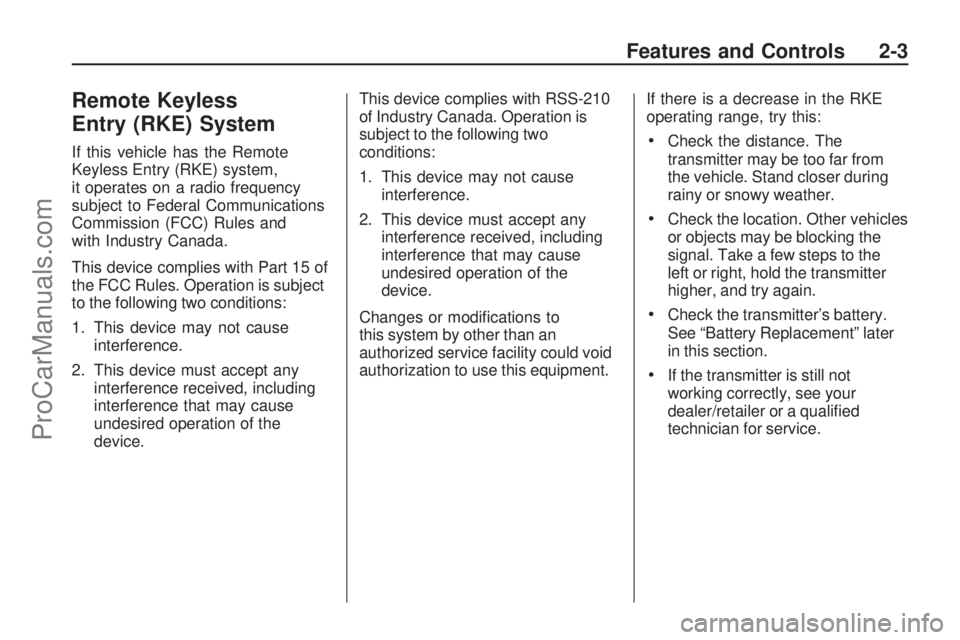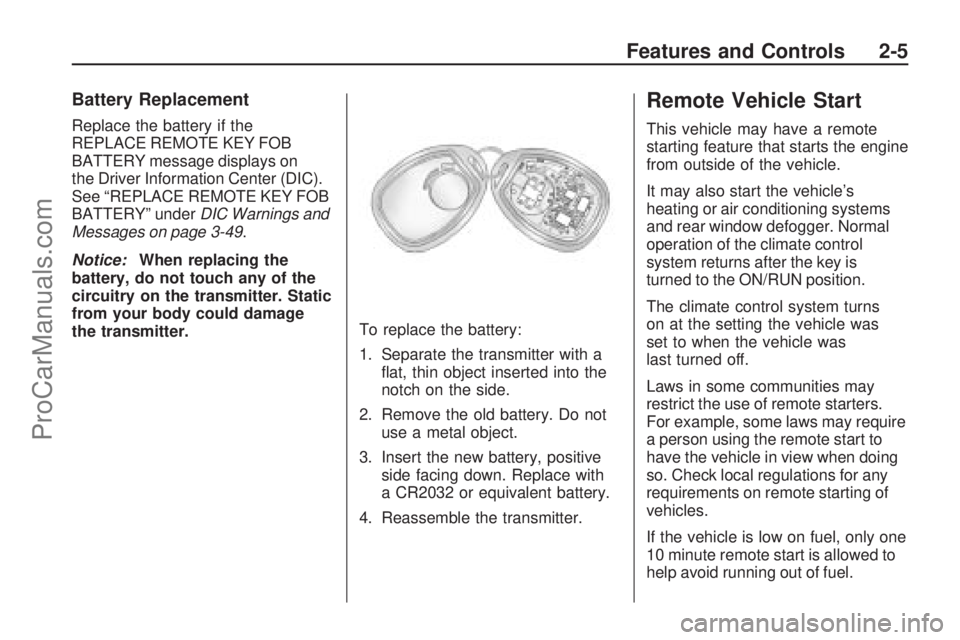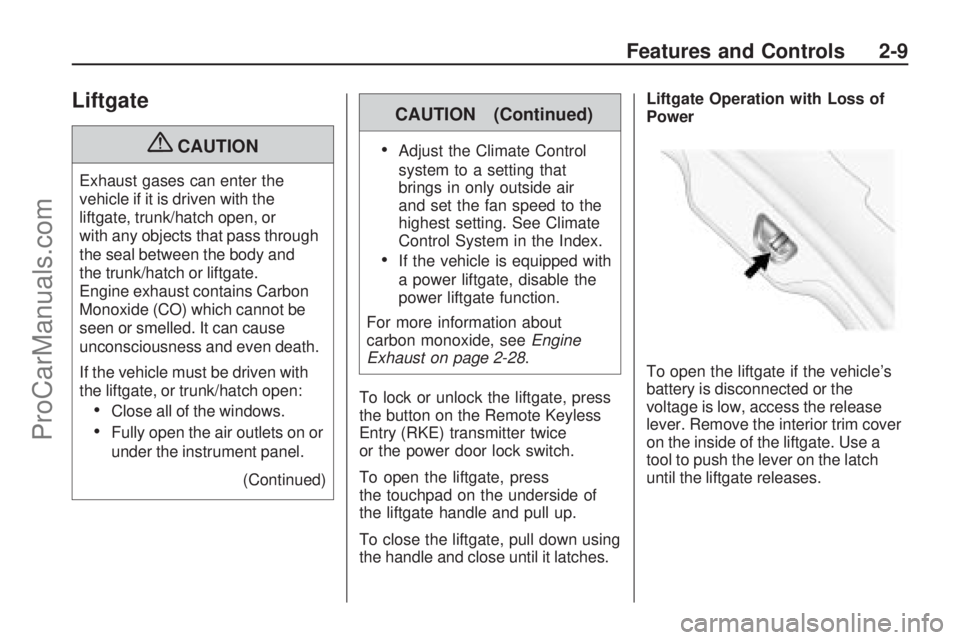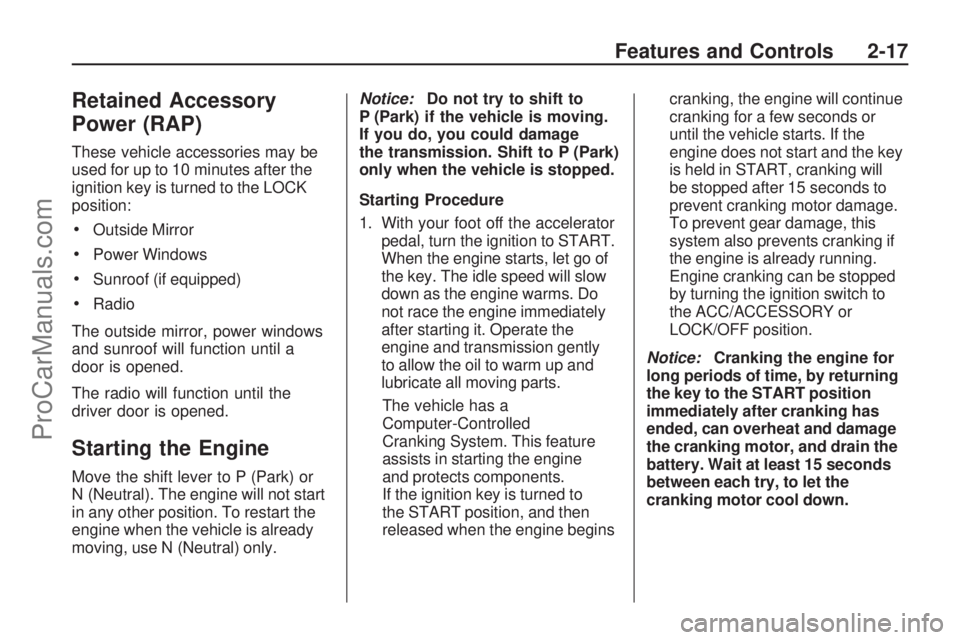key battery SATURN VUE 2009 Owners Manual
[x] Cancel search | Manufacturer: SATURN, Model Year: 2009, Model line: VUE, Model: SATURN VUE 2009Pages: 386, PDF Size: 2.3 MB
Page 67 of 386

Remote Keyless
Entry (RKE) System
If this vehicle has the Remote
Keyless Entry (RKE) system,
it operates on a radio frequency
subject to Federal Communications
Commission (FCC) Rules and
with Industry Canada.
This device complies with Part 15 of
the FCC Rules. Operation is subject
to the following two conditions:
1. This device may not cause
interference.
2. This device must accept any
interference received, including
interference that may cause
undesired operation of the
device.This device complies with RSS-210
of Industry Canada. Operation is
subject to the following two
conditions:
1. This device may not cause
interference.
2. This device must accept any
interference received, including
interference that may cause
undesired operation of the
device.
Changes or modi�cations to
this system by other than an
authorized service facility could void
authorization to use this equipment.If there is a decrease in the RKE
operating range, try this:Check the distance. The
transmitter may be too far from
the vehicle. Stand closer during
rainy or snowy weather.
Check the location. Other vehicles
or objects may be blocking the
signal. Take a few steps to the
left or right, hold the transmitter
higher, and try again.
Check the transmitter’s battery.
See “Battery Replacement” later
in this section.
If the transmitter is still not
working correctly, see your
dealer/retailer or a quali�ed
technician for service.
Features and Controls 2-3
ProCarManuals.com
Page 69 of 386

Battery Replacement
Replace the battery if the
REPLACE REMOTE KEY FOB
BATTERY message displays on
the Driver Information Center (DIC).
See “REPLACE REMOTE KEY FOB
BATTERY” underDIC Warnings and
Messages on page 3-49.
Notice:When replacing the
battery, do not touch any of the
circuitry on the transmitter. Static
from your body could damage
the transmitter.To replace the battery:
1. Separate the transmitter with a
�at, thin object inserted into the
notch on the side.
2. Remove the old battery. Do not
use a metal object.
3. Insert the new battery, positive
side facing down. Replace with
a CR2032 or equivalent battery.
4. Reassemble the transmitter.
Remote Vehicle Start
This vehicle may have a remote
starting feature that starts the engine
from outside of the vehicle.
It may also start the vehicle’s
heating or air conditioning systems
and rear window defogger. Normal
operation of the climate control
system returns after the key is
turned to the ON/RUN position.
The climate control system turns
on at the setting the vehicle was
set to when the vehicle was
last turned off.
Laws in some communities may
restrict the use of remote starters.
For example, some laws may require
a person using the remote start to
have the vehicle in view when doing
so. Check local regulations for any
requirements on remote starting of
vehicles.
If the vehicle is low on fuel, only one
10 minute remote start is allowed to
help avoid running out of fuel.
Features and Controls 2-5
ProCarManuals.com
Page 73 of 386

Liftgate
{CAUTION
Exhaust gases can enter the
vehicle if it is driven with the
liftgate, trunk/hatch open, or
with any objects that pass through
the seal between the body and
the trunk/hatch or liftgate.
Engine exhaust contains Carbon
Monoxide (CO) which cannot be
seen or smelled. It can cause
unconsciousness and even death.
If the vehicle must be driven with
the liftgate, or trunk/hatch open:
Close all of the windows.
Fully open the air outlets on or
under the instrument panel.
(Continued)
CAUTION (Continued)
Adjust the Climate Control
system to a setting that
brings in only outside air
and set the fan speed to the
highest setting. See Climate
Control System in the Index.
If the vehicle is equipped with
a power liftgate, disable the
power liftgate function.
For more information about
carbon monoxide, seeEngine
Exhaust on page 2-28.
To lock or unlock the liftgate, press
the button on the Remote Keyless
Entry (RKE) transmitter twice
or the power door lock switch.
To open the liftgate, press
the touchpad on the underside of
the liftgate handle and pull up.
To close the liftgate, pull down using
the handle and close until it latches.Liftgate Operation with Loss of
Power
To open the liftgate if the vehicle’s
battery is disconnected or the
voltage is low, access the release
lever. Remove the interior trim cover
on the inside of the liftgate. Use a
tool to push the lever on the latch
until the liftgate releases.
Features and Controls 2-9
ProCarManuals.com
Page 80 of 386

Ignition Positions
The ignition switch has four different
positions.
To shift out of P (Park), turn the
ignition to ON/RUN and apply
the regular brake pedal.
Notice:Using a tool to force the
key to turn in the ignition could
cause damage to the switch or
break the key. Use the correct key,
make sure it is all the way in, and
turn it only with your hand. If the
key cannot be turned by hand,
see your dealer/retailer.LOCK/OFF:This position locks the
ignition. It also locks the steering
wheel and the transmission. The key
can only be removed in LOCK/OFF.
The shift lever must be in P (Park)
to turn the ignition switch to
LOCK/OFF.
The steering can bind with the
wheels turned off center. If this
happens, move the steering wheel
from right to left while turning the key
to ACC/ACCESSORY. If this doesn’t
work, the vehicle needs service.
ACC (ACC/ACCESSORY):This is
the position in which you can operate
the electrical accessories or items
plugged into the accessory power
outlets.
Use this position if the vehicle must
be pushed or towed.ON/RUN:This position can be used
to operate the electrical accessories
and to display some instrument
panel cluster warning and indicator
lights. The switch stays in this
position when the engine is running.
The transmission is also unlocked in
this position. If you leave the key in
the ACC/ACCESSORY or ON/RUN
positions with the engine off, the
battery could be drained. You may
not be able to start the vehicle if the
battery is allowed to drain for an
extended period of time.
START:This is the position that
starts the engine. When the engine
starts, release the key. The ignition
switch returns to ON/RUN for driving.
A warning tone will sound when the
driver door is opened, the ignition is
in ACC/ACCESSORY or LOCK/OFF
and the key is in the ignition.
2-16 Features and Controls
ProCarManuals.com
Page 81 of 386

Retained Accessory
Power (RAP)
These vehicle accessories may be
used for up to 10 minutes after the
ignition key is turned to the LOCK
position:
Outside Mirror
Power Windows
Sunroof (if equipped)
Radio
The outside mirror, power windows
and sunroof will function until a
door is opened.
The radio will function until the
driver door is opened.
Starting the Engine
Move the shift lever to P (Park) or
N (Neutral). The engine will not start
in any other position. To restart the
engine when the vehicle is already
moving, use N (Neutral) only.Notice:Do not try to shift to
P (Park) if the vehicle is moving.
If you do, you could damage
the transmission. Shift to P (Park)
only when the vehicle is stopped.
Starting Procedure
1. With your foot off the accelerator
pedal, turn the ignition to START.
When the engine starts, let go of
the key. The idle speed will slow
down as the engine warms. Do
not race the engine immediately
after starting it. Operate the
engine and transmission gently
to allow the oil to warm up and
lubricate all moving parts.
The vehicle has a
Computer-Controlled
Cranking System. This feature
assists in starting the engine
and protects components.
If the ignition key is turned to
the START position, and then
released when the engine beginscranking, the engine will continue
cranking for a few seconds or
until the vehicle starts. If the
engine does not start and the key
is held in START, cranking will
be stopped after 15 seconds to
prevent cranking motor damage.
To prevent gear damage, this
system also prevents cranking if
the engine is already running.
Engine cranking can be stopped
by turning the ignition switch to
the ACC/ACCESSORY or
LOCK/OFF position.
Notice:Cranking the engine for
long periods of time, by returning
the key to the START position
immediately after cranking has
ended, can overheat and damage
the cranking motor, and drain the
battery. Wait at least 15 seconds
between each try, to let the
cranking motor cool down.
Features and Controls 2-17
ProCarManuals.com
Page 91 of 386

Shifting Out of Park
The vehicle has an electronic shift
lock release system. The shift
lock release is designed to:
Prevent ignition key removal
unless the shift lever is in
P (Park) with the shift lever
button fully released.
Prevent movement of the shift
lever out of P (Park), unless
the ignition is in ON/RUN and the
regular brake pedal is applied.
The shift lock release is always
functional except in the case of
an uncharged or low voltage
(less than 9 volt) battery.
If the vehicle has an uncharged
battery or a battery with low voltage,
try charging or jump starting the
battery. SeeJump Starting on
page 5-31for more information.To shift out of P (Park):
1. Apply the brake pedal.
2. Press the shift lever button.
3. Move the shift lever to the
desired position.
If you still are unable to shift out of
P (Park):
1. Fully release the shift lever
button.
2. Hold the brake pedal down and
press the shift lever button again.
3. Move the shift lever to the
desired position.
If you still cannot move the shift
lever from P (Park), consult your
dealer/retailer or a professional
towing service.
Parking Over Things
That Burn
{CAUTION
Things that can burn could touch
hot exhaust parts under the
vehicle and ignite. Do not park
over papers, leaves, dry grass,
or other things that can burn.
Features and Controls 2-27
ProCarManuals.com
Page 147 of 386

Emissions Inspection and
Maintenance Programs
Some state/provincial and local
governments have or might begin
programs to inspect the emission
control equipment on the vehicle.
Failure to pass this inspection
could prevent getting a vehicle
registration.
Here are some things to know to
help the vehicle pass an inspection:
The vehicle will not pass this
inspection if the check engine
light is on with the engine
running, or if the key is in
ON/RUN and the light is not on.
The vehicle will not pass
this inspection if the OBD II
(on-board diagnostic) system
determines that critical emission
control systems have not
been completely diagnosed
by the system. The vehicle
would be considered not readyfor inspection. This can happen
if the battery has recently been
replaced or if the battery has run
down. The diagnostic system is
designed to evaluate critical
emission control systems during
normal driving. This can take
several days of routine driving.
If this has been done and the
vehicle still does not pass the
inspection for lack of OBD II
system readiness, your dealer/
retailer can prepare the vehicle
for inspection.
Oil Pressure Light
{CAUTION
Do not keep driving if the oil
pressure is low. The engine can
become so hot that it catches �re.
Someone could be burned. Check
the oil as soon as possible and
have the vehicle serviced.Notice:Lack of proper engine oil
maintenance can damage the
engine. The repairs would not be
covered by the vehicle warranty.
Always follow the maintenance
schedule in this manual for
changing engine oil.
The oil pressure light should come
on brie�y as the engine is started. If it
does not come on have the vehicle
serviced by your dealer/retailer.
If the light comes on and stays on, it
means that oil is not �owing through
the engine properly. The vehicle
could be low on oil and might have
some other system problem.
Instrument Panel 3-37
ProCarManuals.com
Page 153 of 386

DIC Buttons
The buttons are the trip/fuel,
vehicle information, customization,
and set/reset buttons. The button
functions are detailed in the
following pages.
3(Trip/Fuel):Press this
button to display the odometer,
trip odometer, fuel range, average
economy, fuel used, and elapsed
time. Some vehicles also display
instantaneous economy. The
compass and outside temperature
will also be shown in the display.
The temperature will be shown
in °F or °C depending on the units
selected.
T(Vehicle Information):Press
this button to display the oil life,
units, tire pressure readings
for vehicles with the Tire Pressure
Monitor System (TPMS), Remote
Keyless Entry (RKE) transmitter
programming, compass zone
setting, compass recalibration on
vehicles with this feature, coolant
temperature, and battery voltage.
U(Customization):Press this
button to customize the feature
settings on your vehicle. SeeDIC
Vehicle Customization on page 3-57
for more information.
V(Set/Reset):Press this button
to set or reset certain functions
and to turn off or acknowledge
messages on the DIC.
Trip/Fuel Menu Items
3(Trip/Fuel):Press this button
to scroll through the following
menu items:
Odometer
Press the trip/fuel button until
ODOMETER displays. This display
shows the distance the vehicle
has been driven in either miles (mi)
or kilometers (km). Pressing the
trip odometer reset stem will
also display the odometer.
To switch between English and
metric measurements, see “Units”
later in this section.
Instrument Panel 3-43
ProCarManuals.com
Page 157 of 386

4. To match additional transmitters
at this time, repeat Step 3.
Each vehicle can have a
maximum of eight transmitters
matched to it.
5. To exit the programming mode,
you must cycle the key to
LOCK/OFF.
Compass Zone Setting
This display allows for setting the
compass zone. SeeDIC Compass
on page 3-47for more information.
Compass Recalibration
This display allows for calibrating
the compass. SeeDIC Compass on
page 3-47for more information.Coolant Temperature
Press the vehicle info button
until the coolant temperature is
displayed. The temperature will
be shown in °F or °C depending
on the units selected.
If the coolant temperature display
shows dashes instead of a value,
there may be a problem with the
vehicle. If this happens often, see
your dealer/retailer for service.
Battery Voltage
Press the vehicle info button until
the battery voltage is displayed.
If the battery voltage display shows
dashes instead of a value, there
may be a problem with the vehicle.
If this happens often, see your
dealer/retailer for service.
Blank Display
This display shows no information.DIC Compass
Your vehicle may have a
compass in the Driver Information
Center (DIC).
Compass Zone
The zone is set to zone eight
upon leaving the factory. Your
dealer/retailer will set the correct
zone for your location.
Under certain circumstances,
such as during a long distance
cross-country trip or moving to a new
state or province, it will be necessary
to compensate for compass variance
by resetting the zone through the
DIC if the zone is not set correctly.
Compass variance is the difference
between the earth’s magnetic north
and true geographic north. If the
compass is not set to the zone where
you live, the compass may give false
readings. The compass must be set
to the variance zone in which the
vehicle is traveling.
Instrument Panel 3-47
ProCarManuals.com
Page 164 of 386

REPLACE REMOTE KEY FOB
BATTERY
This message displays if a Remote
Keyless Entry (RKE) transmitter
battery is low. The battery needs
to be replaced in the transmitter.
See “Battery Replacement” under
Remote Keyless Entry (RKE)
System Operation on page 2-4.
SERVICE A/C
(Air Conditioning) SYSTEM
This message displays when there
is a problem detected in the air
conditioning system. Have the
vehicle serviced by your dealer/
retailer.
SERVICE AIR BAG
This message displays when
there is a problem with the airbag
system. Have your vehicle serviced
by your dealer/retailer immediately.
SeeAirbag Readiness Light on
page 3-29for more information.
SERVICE BRAKE SYSTEM
This message displays along with
the brake system warning light if
there is a problem with the brake
system or when the brake �uid level
is low. SeeBrake System Warning
Light on page 3-31. Have the brake
system serviced by your dealer/
retailer as soon as possible.
SERVICE POWER STEERING
If the vehicle has electric power
steering, this message displays if
a problem has been detected with
the power steering. SeeSteering
on page 4-9for more information.
SERVICE STABILITRAK
This message displays if there
has been a problem detected with
StabiliTrak
®. A warning light also
appears on the instrument panel
cluster. SeeStabiliTrak
®Indicator
Light on page 3-33. SeeStabiliTrak®
System on page 4-7for more
information.If this message turns on while you
are driving, pull off the road as soon
as possible and stop carefully. Try
resetting the system by turning the
ignition off and then back on. If this
message still stays on or turns back
on again while you are driving, your
vehicle needs service. Have the
system inspected by your dealer/
retailer as soon as possible.
SERVICE TIRE MONITORING
SYSTEM
On vehicles with the Tire Pressure
Monitor System (TPMS), this
message displays if a part on the
TPMS is not working properly.
The tire pressure light also �ashes
and then remains on during the
same ignition cycle. SeeTire
Pressure Light on page 3-34.
Several conditions may cause
this message to appear. SeeTire
Pressure Monitor Operation on
page 5-53for more information.
If the warning comes on and stays
on, there may be a problem with the
TPMS. See your dealer/retailer.
3-54 Instrument Panel
ProCarManuals.com